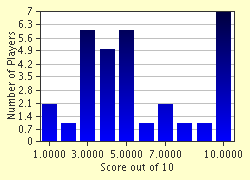Quiz Answer Key and Fun Facts
1. The island we now refer to as Puerto Rico, as well as the smaller islands in the Puerto Rican archipelago, were originally settled by the Ortoiroid people. Approximately when did this initial occupation begin?
2. Around 1000 BC, a particular group of the Arawak people successfully occupied most of the Antilles, including the island now called Puerto Rico. It consisted of a matrilineal people who lived divided into a number of chiefdoms. What was the name of this group of people who were eventually encountered by Christopher Columbus?
3. In what year did Christopher Columbus make his second voyage to the New World and arrive on the island of Puerto Rico, at that time called Boriken, which Columbus renamed San Juan Bautista (sometimes called San Juan)?
4. In 1508, a certain individual, who had accompanied Christopher Columbus and assisted in the colonization of Hispaniola, was granted permission by Queen Isabella to explore San Juan Bautista (Puerto Rico). On a strategically situated bay on the northern coast, he established Caparra and became the island's first European governor. Who was this certain individual?
5. In 1595, this famous (or perhaps infamous) Englishman and his fleet attacked the Spanish at the port of San Juan but failed to capture it. Who was this vice admiral, navigator, and privateer who was the bane of Spain?
6. Puerto Rico remained under Spanish control for several decades and existed with a plantation economy specializing particularly in the production of sugarcane and coffee. When Napoleon invaded the Iberian peninsula, he set up his brother Joseph on the Spanish throne, and many South and Central American colonies took advantage, rebelled, and established their autonomy. Puerto Rico, however, did not. When the Spanish government was restored, King Ferdinand VII rewarded Puerto Rico with numerous freedoms previously not enjoyed by its people. What year were these freedoms granted, the very next year after the return of King Ferdinand?
7. Spain eventually lost Puerto Rico (as well as Cuba, Guam, and the Phillipines) to the United States of America, a result of the short-lived Spanish-American War and the Treaty of Paris, which ended it. In what year was the Treaty of Paris signed and, thus, Puerto Rico ceded to the United States?
8. Signed by U.S. President Woodrow Wilson in 1917, this act declared Puerto Rico an official United States Territory and gave United States citizenship to the island's inhabitants. What was the name of this act?
9. In 1935, United States President Franklin D. Roosevelt, as part of his New Deal program, issued Executive Order 7057 to establish an agency that would revitalize Puerto Rico's economy through agricultural redevelopment and the progressive practices of reforestation, greater access to electric power, a better road and highway system, and improved housing. What was the name of this agency?
10. During what year did Puerto Rico officially become a Commonwealth, which meant it had greater self-rule and the right to create its own consitution but still remained a United States Territory ultimately governed by the United States Congress and President?
Source: Author
alaspooryoric
This quiz was reviewed by FunTrivia editor
bloomsby before going online.
Any errors found in FunTrivia content are routinely corrected through our feedback system.


